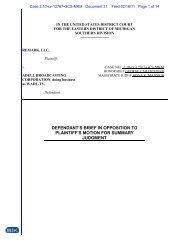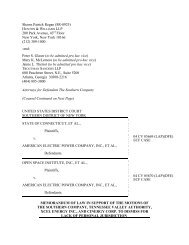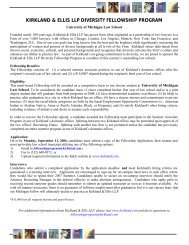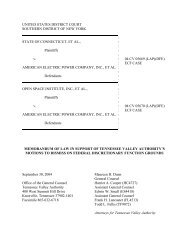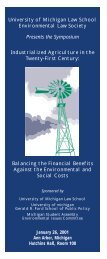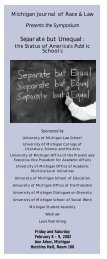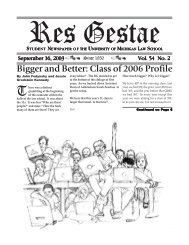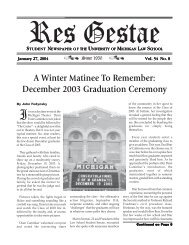REPLY BRIEF ON DEFENDANT'S MOTION TO DISMISS ...
REPLY BRIEF ON DEFENDANT'S MOTION TO DISMISS ...
REPLY BRIEF ON DEFENDANT'S MOTION TO DISMISS ...
You also want an ePaper? Increase the reach of your titles
YUMPU automatically turns print PDFs into web optimized ePapers that Google loves.
Case 2:10-cv-12767-GCS-MKM Document 29 Filed 01/31/11 Page 2 of 6<br />
1282, 1296 (1991): ATo establish infringement, two elements must be proven: (1) ownership of<br />
a valid copyright and (2) copying of constituent elements of the work that are original.@<br />
(Boldface added.) The Feist Court emphasized that only original content is protectable: “As we<br />
have explained, originality is a constitutionally mandated prerequisite for copyright protection.”<br />
499 U.S. at 351. The principal Sixth Circuit case on proof of copyright infringement, Kohus v.<br />
Mariol, 328 F.3d 848, 853 (6 th Cir. 2003), follows the Feist rule on originality: “Not all<br />
„copying‟ is actionable, however: it is a constitutional requirement that a plaintiff bringing an<br />
infringement claim must prove „copying of constituent elements of the work that are original.‟<br />
Feist Publ'ns, Inc. v. Rural Tel. Serv. Co., 499 U.S. 340, 361, 111 S.Ct. 1282, 113 L.Ed.2d 358<br />
(1991) (emphasis added).” Under the Sixth Circuit‟s test for infringement, the “substantial<br />
similarity” analysis does not compare the accused work and the copyrighted work in their<br />
entireties; rather, only the “protectable elements” of the copyrighted work are compared to the<br />
accused work. Kohus, 328 F.3d at 855.<br />
Remark does not identify any original content of any work in its pleading; only some<br />
“common expressive and distinctive elements” distilled from a cloud of unregistered works. See<br />
FAC 8 and 9. Remark then purports to compare “expressive elements,” not original elements,<br />
in its multitude of unregistered works with Adell Broadcasting‟s accused commercials. By using<br />
this erroneous legal standard, Remark fails to plead a claim upon which relief can be granted.<br />
On pages 7-9 of its opposition brief, Remark argues that the Supreme Court in Reed<br />
Elsevier, Inc. v. Muchnick, 130 S. Ct. 1237 (2010) “rejected” the rule that only the new matter in<br />
a derivative work is protectable. Remark seriously misstates the holding of Reed Elsevier; the<br />
Supreme Court made no such rejection. The “rule” is statutory, 17 U.S.C. §103(b) (“The<br />
2



